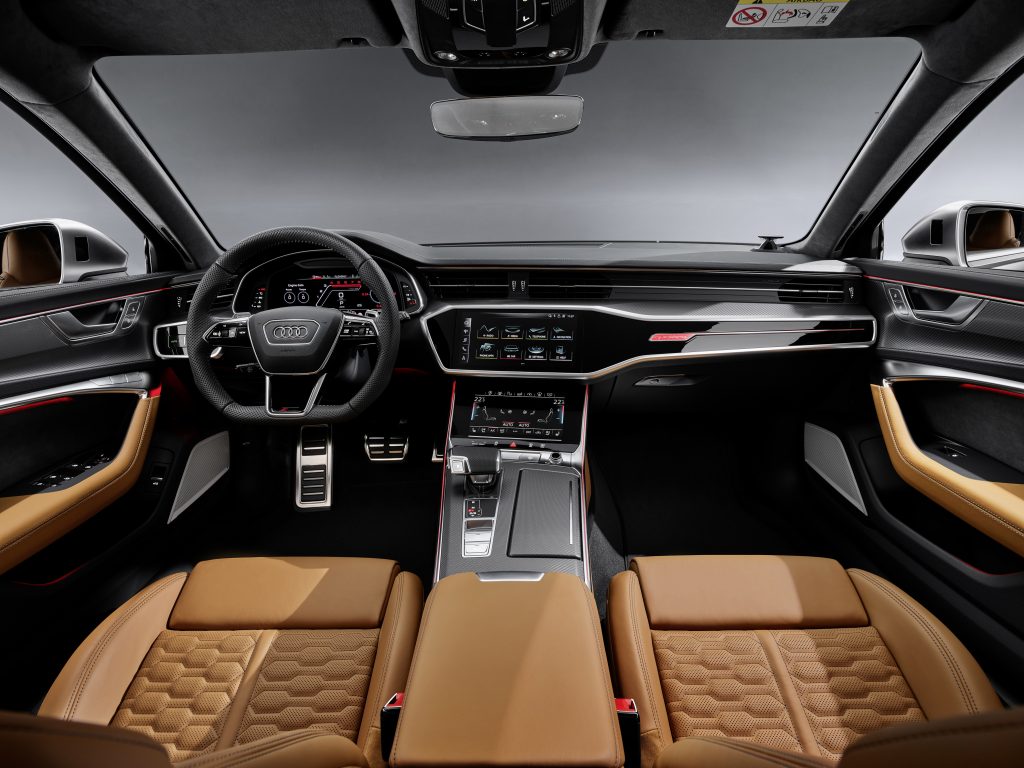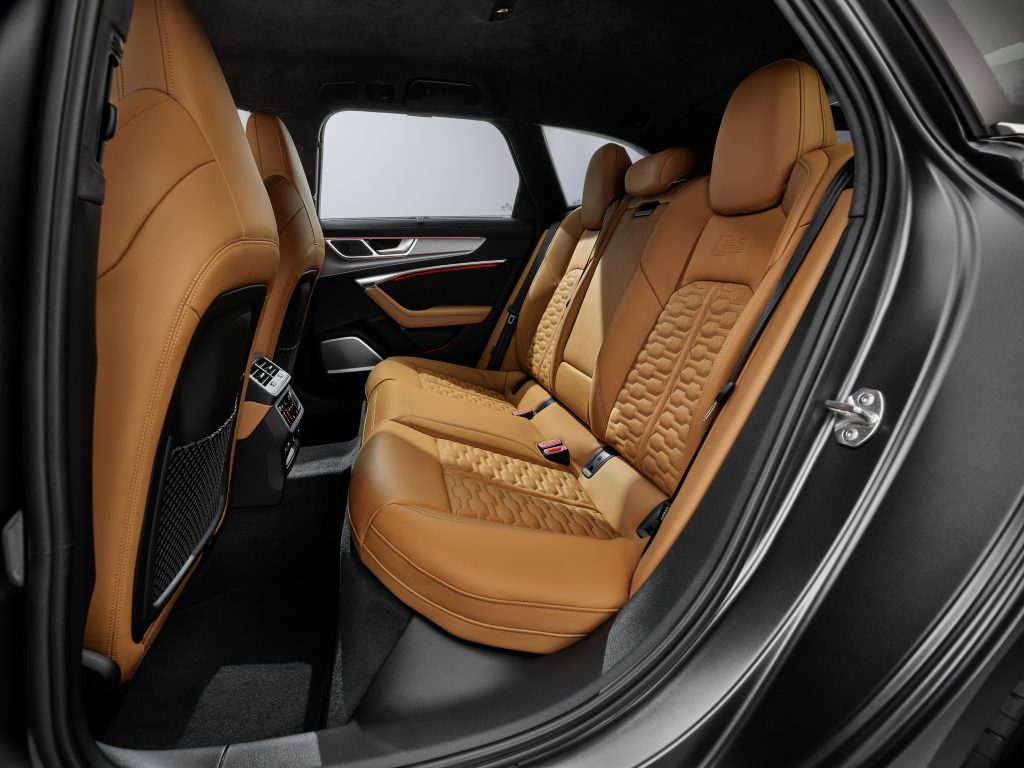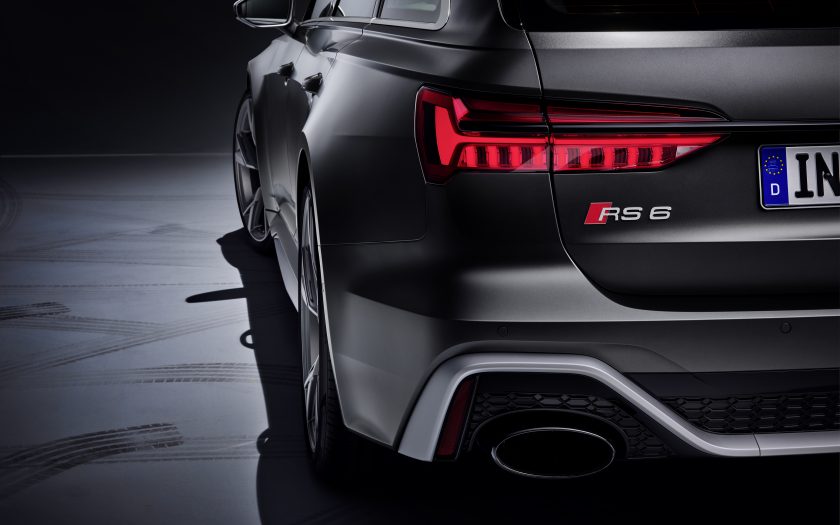AFTER AN ASTONISHING 25 years of RS models, Audi says it is “ushering in a new chapter” with its new RS 6 Avant.
“Throughout our 25-year RS history, the Audi RS 6 Avant is one of our absolute icons with a large global fan base,” says Oliver Hoffmann, Managing Director of Audi Sport GmbH.
Broad, powerful exterior design
The RS model sports an emphatically different design compared with the A6 Avant base model. With the exception of the front doors, roof and tailgate, the exterior is made up of RS-specific parts. The body, which has been widened around 40 millimetres on each side with its broad flared wheel arches, emphasises the sporty flair and the distinctive character of the high-performance Avant.
The new RS 6 Avant is one of the first Audi Sport models to feature the new RS design language. Its entire front-end is significantly different, providing a distinctive look within the A6 model line. In addition to the new bonnet together with powerdome, the RS 6 Avant also adopts the front headlights from the A7 model line. These offer the option of the RS Matrix LED laser headlight with darkened trims as an additional unique selling feature of the RS 6 Avant in the A6 family. Similar to the LED rear lights, they feature a dynamic turn signal along with RS-specific sequencing when the vehicle is locked and unlocked.
The three-dimensional honeycomb structure within the Singleframe grille is finished in gloss black. The Singleframe surround and the quattro logo in the bumper have been eliminated. Below the standard LED headlights, side air inlets open on the strikingly drawn new RS bumper and extend almost into the lower edge of the headlights. The designers have taken their cue from the front-end of the Audi R8 supercar.
In side view, elongated front section, long, straight roofline and flat D pillars, which rest on the quattro blisters stand the RS 6 apart. The RS-specific sills with black inserts visually emphasise pronounced forward thrust. The dynamic rear-end consists of the roof edge spoiler and an RS-specific bumper with rear diffuser and design elements in gloss black. In hallmark RS style, the RS exhaust system flows on both sides into oval chrome-coloured tailpipes – an RS sport exhaust system with black tailpipes is available as an option.

An epic engine
The 4.0 TFSI in the new Audi RS 6 Avant delivers 441kW, and 800Nm of torque between 2100 and 4500rpm. In just 3.6 seconds the high-performance station wagon sprints from zero to 100km/h and in 12 seconds reaches 200km/h, something you’ll only ever see on a race track in Australia unless you don’t value your licence. Top speed is electronically governed at 250km/h. With the optional dynamic package, the RS station wagon does up to 280km/h or up to 305km/h with the dynamic package plus.
Thanks to the 48-volt main electrical system the twin-turbo V8 combines maximum performance with high efficiency. A belt alternator starter lies at the heart of the mild hybrid system (MHEV). Up to 12kW of power can be recovered during light deceleration and stored in a separate lithium-ion battery. If the driver takes their foot off the accelerator at a speed between 55 and 160km/h, the drive management selects one of two options: Depending on the driving situation and setting in the Audi drive select the new RS 6 Avant recovers energy or coasts up to 40 seconds with the engine switched off. Pressing the accelerator makes the belt alternator starter restart the engine. MHEV technology allows for start/stop operation at speeds of up to 22km/h. Fuel savings of up to 0.8 litres per 100 kilometres are possible in everyday driving – yes, these things are important to car companies!
The cylinder on demand (COD) system is also onboard as another efficiency component. At low to intermediate load and speed, it deactivates cylinders 2, 3, 5 and 8 in the high gears by switching off injection and ignition and closing the intake and exhaust valves. In four-cylinder operation the operating points in the active cylinders are displaced toward higher loads in areas of the characteristic map with higher efficiency, while the deactivated cylinders largely run without losses, like gas springs. When the driver presses the accelerator pedal, they are reactivated instantly.
For all its efficiency the 4.0 TFSI doesn’t forego a sporty, voluminous V8 sound. The driver can influence the engine sound using the Audi drive select system. The optional RS sport exhaust system with black tailpipe trims ensures the maximum sporty sound experience. In the customisable RS1 and RS2 modes, customers decide themselves whether the sound should be sporty or balanced.
The standard eight-speed Tiptronic with optimised shift times and the always-superfluous Launch Control function transmits the power of the 4.0 TFSI to the quattro permanent all-wheel drive. The drive forces are distributed to the front and rear axle in a ratio of 40:60 via the all-mechanical centre differential. If one wheel slips, more drive torque automatically goes to the axle with the better traction. Up to 70 percent can flow to the front wheels and up to 85 percent to the rear wheels.
The wheel-selective torque control brakes the wheels with reduced load on the inside of a bend slightly before they can begin to spin. The quattro sport differential in the optional dynamic package and dynamic package plus shifts the drive torque when cornering at speed as required between the rear wheels, improving traction, stability and dynamics.

Agile suspension
On the new RS 6 Avant, the front and rear axles use a five-link design to handle the induced longitudinal and transverse forces separately.
The standard RS adaptive air suspension with controlled damping was tuned specifically for the RS and provides, thanks to the new air spring module with a 50 percent higher spring rate, a top speed of 305km/h for the first time in conjunction with the dynamic package plus. It can be set to several modes and includes automatic level control. The body of the new RS 6 Avant is 20 millimetres lower than on the Audi A6 Avant with standard suspension and at speeds of 120km/h and above, it is lowered by another 10 millimetres. A lift mode raises the vehicle by 20 millimetres at low speed. The very wide spread of the RS sport air suspension offers the driver a free choice between long-distance comfort and maximum performance.
The RS sport suspension plus with Dynamic Ride Control (DRC) is available as an alternative and uses steel springs and three-stage adjustable dampers that are connected to one another via diagonal oil lines and a central valve. When cornering at speed, the valves regulate the oil flow in the damper of the spring-deflected front wheel at the outside of the curve. They increase the support provided and reduce pitch and roll movements. This lets the RS 6 Avant hug the road more tightly and improves handling. A new damper generation with integrated control valve ensures much more noticeable spread between the individual modes of the Audi drive select system.
The new RS 6 Avant comes standard with the progressive steering and a direct ratio. The system develops significantly higher return forces with increasing steering angle for precise steering feedback. Its newly developed power assist directly connects the driver and road. Optionally with the dynamic package and dynamic package plus the new RS 6 Avant comes with dynamic all-wheel steering. It combines dynamic steering at the front axle, which uses an infinitely variable strain wave gearing, with a separate rear axle steering system with a spindle drive and track rods. At low speeds, the rear wheels turn as much as five degrees in the opposite direction relative to the front wheels. This reduces the turning circle by up to one metre, making the RS 6 Avant more agile in city traffic and tight curves. At intermediate and high speeds, the rear wheels turn by up to two degrees in the same direction – promoting stability particularly when changing course quickly.
The driver can change the character of their RS 6 Avant using the Audi drive select dynamic handling system. Six profiles are available: comfort, auto, dynamic, efficiency, and the individually configurable RS-specific RS1 and RS2 modes, which can be activated directly using the “RS MODE” steering wheel button. This automatically opens the RS-specific displays in the Audi virtual cockpit. The Audi drive select dynamic handling system influences the engine and transmission management, the power steering, the suspension, the dynamic all-wheel steering, the quattro sport differential, the engine sound and the characteristics of the automatic air conditioning. The RS2 mode exists specifically to influence the Electronic Stabilisation Control (ESC) directly at the push of a button.
The new RS 6 Avant is fitted standard with 21-inch cast aluminium wheels in 10-spoke star design, which are shod with 275/35 tyres. An RS-specific wheel in 22-inch 5-V-spoke trapezoid design with 285/30 tyres is available as an option, in a choice of silver, matt titanium look, gloss turned finish, and gloss anthracite black, gloss turned finish. The callipers of the RS steel brake system with ventilated and perforated discs (420 millimetres front, 370 millimetres rear) are painted black as standard and are optionally available in red. With the optional RS ceramic brakes, the callipers come in a choice of grey, red or blue. Their discs measure 440 millimetres (front) and 370 millimetres (rear). The newly developed RS ceramic brake system weighs around 34 kilograms less than its steel counterpart, reducing unsprung masses. The Electronic Stabilisation Control (ESC) features a sport mode or can be switched off entirely.
Sports oriented interior
The pioneering interior design accentuates the sporty character of the new RS 6 Avant with its driver orientation and inlays in aluminium race, anthracite. With its horizontal alignment and its tiered, three-dimensional structure, the instrument panel has a light, sleek appearance. The user interface of the all-digital operating system harmonises with the clear black-panel design. The top MMI touch response display is incorporated almost invisibly into the black-panel architecture. The “RS Monitor” display provides the driver with the option of having the top display provide an overview of the temperature status of the drive components, the maximum g acceleration figures along with information on tyre pressure and temperature.
In the Audi virtual cockpit, special RS displays provide information on tyre pressure, torque, power output, engine oil temperature, boost pressure, lap timings, acceleration measurements and g-forces. The shift light display prompts the driver to upshift when the maximum engine speed is reached and the optional head-up display also provides several RS-specific graphic displays.
The fully perforated sport leather steering wheel, flattened at the bottom, with new large RS shift paddles made of aluminium, features multifunction buttons that allow the driver to also directly select the new Audi drive select RS1 and RS2 modes. RS and RS 6 logos adorn the interior on the steering wheel, seats and the illuminated front door sill trims. The Audi Sport emblem is projected onto the road when the front or rear doors are opened.
The sport seats in black pearl Nappa leather/Alcantara come with RS embossing and rhombus pattern. As an option, RS sport seats are available in perforated Valcona leather with honeycomb pattern and RS embossing. Their perforation also allows ventilation for the first time. Two RS design packages, red and grey, bring colour and additional sportiness to the interior – with this option, the steering wheel rim, gear lever gaiter and knee pads are in Alcantara with contrasting stitching. Belt straps with colour edging and RS floor mats round out the package. Inlays in carbon, wood natural, grey-brown, or matt aluminium add further customisation options.
The new RS 6 Avant is even roomier inside. The luggage compartment has a capacity of between 565 and 1680 litres, while the loading width between the wheel arches is now 1.05 metres, 14 millimetres larger than the previous model. The split-folding rear seat bench in the ratio 40:20:40 can be released and folded conveniently from the luggage compartment – the luggage compartment length has grown to 1.99 metres as a result. A power tailgate and luggage compartment cover are standard. In combination with the optional convenience key, sensor control allows the tailgate to be opened with a foot gesture. The optional swiveling trailer towing hitch features an electric release function. Also available as an option is the camera-based trailer assist, which helps the driver when reversing and manoeuvring with a trailer.

Wide range of infotainment, assist systems, colours and materials
The new RS 6 Avant comes with extensive comfort, connectivity and driver assist equipment. More than 30 assist systems are available – including adaptive cruise assist, intersection assist, lane change warning, curb warning and 360-degree cameras.
The paint range for the new Audi RS 6 Avant comes with 13 colours, including the two RS-specific colours Nardo grey and Sebring black, crystal effect along with a choice of five matt effect paint finishes. The exterior mirror housings come standard in black and are optionally also available in the body colour or matt aluminium. The matt aluminium, black and carbon styling packages change the vertical blades, the horizontal splitter, the sill inserts, roof rails and window slot trims as well as the rear diffuser trim. The Audi rings and the RS logos at the front and rear can also be finished in gloss black as an option for the black and carbon styling packages. The Audi exclusive range offers numerous other customisation options.
Australian information
The new Audi RS 6 Avant is expected to arrive in Australia in mid-2020. Pricing and specification will be announced closer to launch.
Once we have tested and assessed the new Audi RS 6 Avant, seniordriveraus will bring you a comprehensive review, including everything the over-50 driver needs to know.
